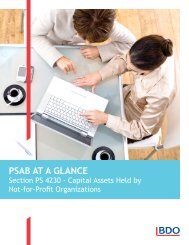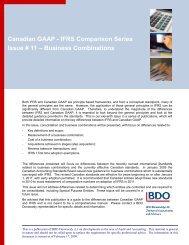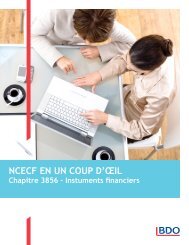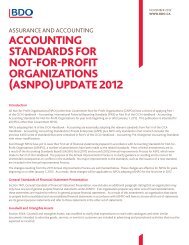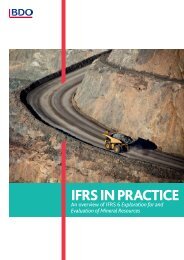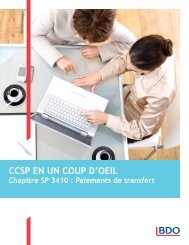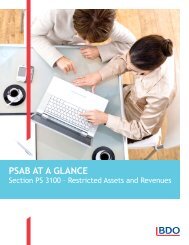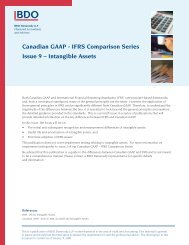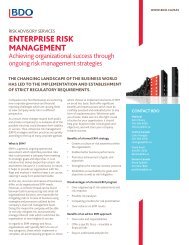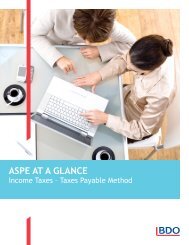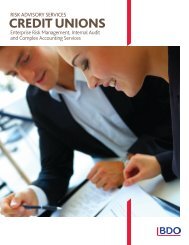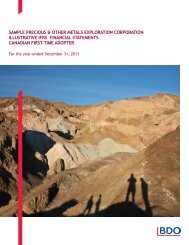Need to Know: IFRS 10 - Consolidated Financial ... - BDO Canada
Need to Know: IFRS 10 - Consolidated Financial ... - BDO Canada
Need to Know: IFRS 10 - Consolidated Financial ... - BDO Canada
- No tags were found...
Create successful ePaper yourself
Turn your PDF publications into a flip-book with our unique Google optimized e-Paper software.
<strong>IFRS</strong> <strong>10</strong> <strong>Consolidated</strong> <strong>Financial</strong> Statements417.7. Accounting requirementsThe accounting requirements for consolidated financial statements have been carried forward from IAS 27(2008)and do not feature material changes, although some of the terminology is different.The general accounting requirements in <strong>IFRS</strong> <strong>10</strong> include:Consolidation procedures1. Like items of assets, liabilities, equity, income, expenses and cash flows of the parent and its subsidiaries arecombined2. The carrying amount of the parent’s investment in each subsidiary and the parent’s portion of its interest in theequity of each subsidiary is eliminated3. Intragroup assets and liabilities, equity, income, expenses and cash flows relating <strong>to</strong> transactions between entitiesof the group are eliminated in full (profits or losses resulting from intragroup transactions that are recognised inassets, such as inven<strong>to</strong>ry and fixed assets are also eliminated in full) (<strong>IFRS</strong> <strong>10</strong>.B86).Uniform accounting policiesThe consolidated financial statements are required <strong>to</strong> be prepared with uniform accounting policies. This means thatlike transaction or events should be accounted for in a similar way by the parent and its subsidiaries (<strong>IFRS</strong> <strong>10</strong>.19).If a member of the group uses accounting policies other than those adopted in the consolidated financial statementsadjustments are required <strong>to</strong> that member’s financial statements <strong>to</strong> ensure conformity with the group’s accountingpolicies (<strong>IFRS</strong> <strong>10</strong>.B87).Reporting dateThe financial statements of the parent and its subsidiaries used for consolidation purposes should have thesame reporting date. When a subsidiary has different year end it is required <strong>to</strong> make adjustments <strong>to</strong> its financialstatements <strong>to</strong> match the parents reporting date unless it is impracticable (this would be the case the entity cannotmake the adjustments after making every reasonable effort <strong>to</strong> do so) (<strong>IFRS</strong> <strong>10</strong>.B92).If it is impracticable <strong>to</strong> make adjustments a parent is permitted <strong>to</strong> consolidate the subsidiary using its most recentfinancial statements adjusted for the effects of significant transactions or events that have occurred between thedifferent reporting dates. The difference between the parent’s and the subsidiary’s reporting date in any case cannotbe more than three months. The length of the reporting periods and the difference between the dates is required <strong>to</strong>be the same from period <strong>to</strong> period (<strong>IFRS</strong> <strong>10</strong>.B93).Start and end of consolidationConsolidation of an investee is required <strong>to</strong> start from the date on which an inves<strong>to</strong>r obtains control of an investeeand cease when the inves<strong>to</strong>r loses control of the investee (<strong>IFRS</strong> <strong>10</strong>.20).<strong>IFRS</strong> 3 Business Combinations provides guidance on when a parent obtains control over subsidiary when it meets thedefinition of a business.



